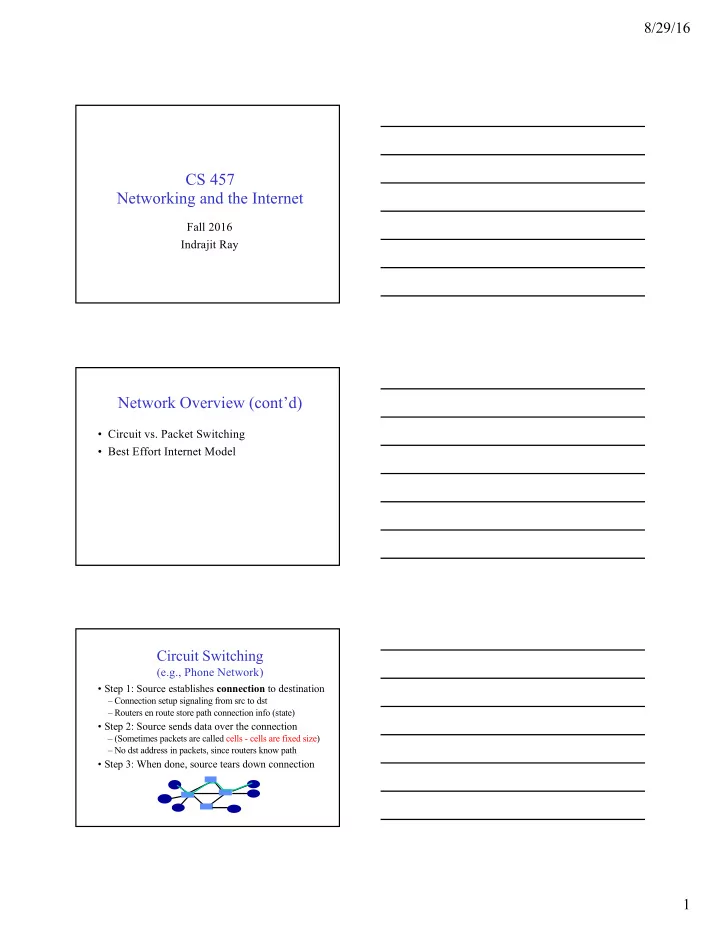

8/29/16 CS 457 Networking and the Internet Fall 2016 Indrajit Ray Network Overview (cont’d) • Circuit vs. Packet Switching • Best Effort Internet Model Circuit Switching (e.g., Phone Network) • Step 1: Source establishes connection to destination – Connection setup signaling from src to dst – Routers en route store path connection info (state) • Step 2: Source sends data over the connection – (Sometimes packets are called cells - cells are fixed size) – No dst address in packets, since routers know path • Step 3: When done, source tears down connection 1
8/29/16 Virtual Circuits (VC) • Need call setup/teardown for each call before data can flow • Each packet carries VC identifier (not destination host address) • Every router on src-dst path maintains “state” for each passing connection • Link, router resources (bandwidth, buffers) may be allocated to VC • Example network: ATM (Asynchronous Transfer Mode) VC Implementation A VC consists of: 1. Path from source to destination 2. VC numbers, one number for each link along path 3. Entries in forwarding tables in routers along path • Packet belonging to VC carries a VC number in the header • VC number may change (and usually does) on each link. – VCs are negotiated between neighboring routers Forwarding Tables VC number R1 R2 22 32 12 3 1 2 Forwarding table in R1: interface number Incoming interface Incoming VC # Outgoing interface Outgoing VC # C1: 1 12 3 22 2 63 1 18 3 7 2 17 1 97 3 87 … … … … Routers maintain connection state information! What is the forwarding state in R2 for C1? 2
8/29/16 Advantages of Circuit Switching • Easy to provide performance guarantees –Bandwidth can be reserved along the entire path –Fixed path means virtually constant latency • Simple abstraction –Reliable communication channel between hosts –No worries about lost or out-of-order packets • Simple forwarding –Based on time slot, frequency or label –No need for complex packet header –Low per-packet overhead Disadvantages of Circuit Switching • With reservations, wasted BW (need peak BW) – Idle resources during silent periods – Unable to achieve gains from statistical multiplexing • Blocked connections – Connection refused when resources are not sufficient – Unable to offer “okay” service to everybody • Connection set-up delay – No communication until a connection is set up (1 RTT) – Unable to avoid extra latency for small data transfers • Network state – Network nodes must store per-connection state – Unable to avoid per-connection storage and state Packet Switching (e.g., Internet) • Messages divided into globally addressable packets (Datagrams) – Each packet’s header contains a dst address • Packets may travel separately through network – Packet forwarding based on the header – Network nodes may store packets temporarily • Destination reconstructs the message 3
8/29/16 IP Service Model: Why Packet Switching? • In one word: Flexibility! • Data traffic is bursty – Remote login, email, video, voice, etc. • Packets don’t waste reserved bandwidth – No traffic exchanged during idle periods • Packets better for multiplexing – Different transfers share access to same links • Packets can be delivered by almost anything – Best effort service – RFC 2549: IP over Avian Carriers (aka birds) • … still, packet switching can be inefficient – Extra header bits Network Architecture: Internet vs. POTS* • There is a fundamental architectural difference between Internet and telephone network • POTS: Intelligent network, dumb terminals – Reliable, in-sequence, guaranteed delivery (bandwidth and delay) • Internet: Dumb network, intelligent endpoints – Best effort delivery (unreliable, packets may arrive out of sequence and duplicated, no bandwidth or delay guarantees) (*POTS: Plain Old Telephone System) IP Service Model: Why Best-Effort? • Flexibility: Network does not dictate applications • IP means never having to say you’re sorry… – Don’t need to reserve bandwidth and memory – Don’t need to do error detection & correction – Don’t need to remember from one packet to next – Can’t get any simpler than that! • Easier to survive failures – Transient disruptions are okay during failover • … but, applications do want efficient, accurate transfer of data in order, in a timely fashion – IP pushes these to the higher layers 4
8/29/16 IP Service: Is Best-Effort Enough? • No error detection or correction – Higher-level protocol can provide error checking • Successive packets may not follow the same path – Usually not a problem as long as packets get there • Packets can be delivered out-of-order – Number packets so they can be put back in order • Packets may be lost or arbitrarily delayed – Sender can send the packets again (if desired) • No network congestion signal (beyond “drop”) – Sender can slow down in response to loss or delay (but this is a really hard problem..) To Think About.. • Think about the diametrically opposing architectural difference: – Smart Network, dumb endpoints, vs. Stupid Network, Intelligent Endpoints. • Which one provides more flexibility? • Which one allows more future innovation? • What do you think about the KISS principle? (Keep It Simple, Stupid) 5
Recommend
More recommend